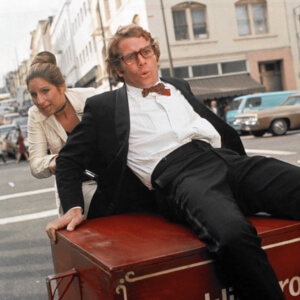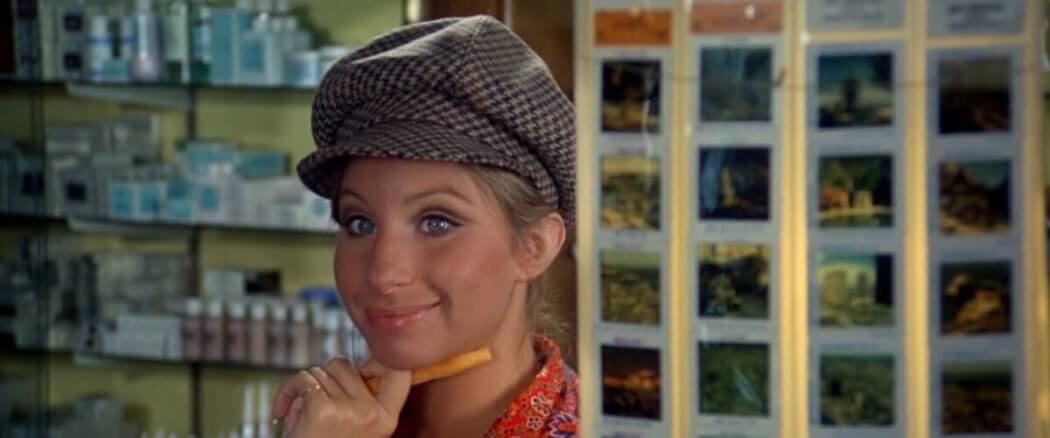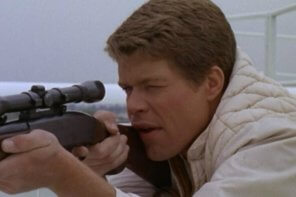“Because children have abounding vitality, because they are in spirit fierce and free, therefore they want things repeated and unchanged,” writes G.K. Chesterton in Orthodoxy, “They always say, ‘Do it again’; and the grown-up person does it again until he is nearly dead. For grown-up people are not strong enough to exult in monotony.”
If any grown-up people are strong enough to exult in monotony, it’s those working in comedy. The form depends on timing — a metronomaniacal sense of beat after beat — the craft of repetition. And if you’re trying to imitate the masters, an extra strength of obsession is required. But Peter Bogdanovich, the director and producer of What’s Up, Doc? “isn’t an imitator so much as an admirer with ideas of his own.”*
You Can’t Fight a Tidal Wave
“I couldn’t follow the story myself,” Barbra Streisand admits in the commentary — and no one could, at least upon first viewing. The inciting incident is Judy Maxwell (Streisand), a charming opportunist whose mind and mouth move at almost record-breaking speed. “You can’t fight a tidal wave,” she smiles at one point, offering a neat character description and plot summary.
 For some reason — perhaps pure whimsy — Judy chooses Howard Banister (Ryan O’Neal), the squarest of them all, as her object of affection. Howard is a musicologist, attending a conference in San Francisco, where he’s competing for a grant; Eunice Burns (Madeline Kahn) is apparently his fiancée but behaves more like a manager. If we weren’t already sure of the final pairing, we learn that Judy and Howard have matching overnight cases.
For some reason — perhaps pure whimsy — Judy chooses Howard Banister (Ryan O’Neal), the squarest of them all, as her object of affection. Howard is a musicologist, attending a conference in San Francisco, where he’s competing for a grant; Eunice Burns (Madeline Kahn) is apparently his fiancée but behaves more like a manager. If we weren’t already sure of the final pairing, we learn that Judy and Howard have matching overnight cases.
Unfortunately, there are two other identical cases, owned by a jewel collector and a government operative. As the plots thicken and paths cross, the bags are mistook and taken and taken again. The consequences are a hysterical devastation of dignity and property, all under the literal banner of “Keep San Francisco Clean” and climaxing in a chase sequence that consumed a month of the shooting schedule and ¼ of its total budget. “It was a cartoon, a screwball comedy, a slapstick farce,” Bogdanovich remarked, “altogether.”**
Energy and Ego
“Bogdanovich has spent thousands of hours absorbing the film techniques of famous directors,” Jay Anson wrote. “He not only enjoys making movies, he lives them, and somehow projects that energy.”*** That energy — and ego — shot him right into the inner ring of the entertainment industry. At 16, he studied with Stella Adler; at 20, he directed one of Clifford Odets’ plays off-Broadway; throughout his 20s, he befriended and wrote about all of his favorite directors, including Orson Welles, John Ford, and Howard Hawks.****
It was Hawks’ film Bringing Up Baby that provided Bogdanovich with the premise of What’s Up, Doc? and O’Neal with a role model: Cary Grant. “Ryan was unsure about comedy,” Bogdanovich said. “Off set he’s very funny and relaxed, on camera he freezes up a bit. Ryan can’t act himself on a movie, he needs direction to do it.”***** Whereas Streisand found it “[easy] to do comedy, which is why she didn’t think that much of it.”****** Bogdanovich gave line readings to both of them, mimicking Grant, Hepburn, Lewis, Stanwyck, and more. As an actor, that’s insulting, but as a classic film fan, it’s stunning, like meeting the child of a dear friend who died years ago.
Make-Believe Town
What’s Up, Doc? isn’t littered with references, it’s built on a garbage dump of them. Yet there are so many original components, too. One is the combination of genres, which, though each located in comedy, were not usually mixed. Certainly, this is due in part to the screenplay, a feat of engineering that the writers credit mostly to Buck Henry. It’s also Polly Platt’s production design, which tunes all of the elements with a clever use of color and style; as she explained, “I’m the sort of person who sees the big picture.” More than seeing, “she knew all the departments, on a workmanlike basis, as opposed to most producers who just know things in theory.”******* It was Platt’s suggestion to switch the casting of Streisand and O’Neal and change the location from Chicago to the “make-believe town” of San Francisco.********
 That make-believe is captured by cinematographer László Kovács, from sunrise to golden hour to amazingly realistic transparencies of the city at night. Just watch how he and Platt use the same turquoise dress over the course of several scenes. You won’t find that difficult, because the actor wearing it is Madeline Kahn, who might just be the film’s most unique ingredient. What’s Up, Doc? was Kahn’s first appearance, and if she’d never appeared again, it would have been enough to secure her status as a comedic genius. She could just whimper a little and get a laugh; she could get a laugh from a line that wasn’t even funny.
That make-believe is captured by cinematographer László Kovács, from sunrise to golden hour to amazingly realistic transparencies of the city at night. Just watch how he and Platt use the same turquoise dress over the course of several scenes. You won’t find that difficult, because the actor wearing it is Madeline Kahn, who might just be the film’s most unique ingredient. What’s Up, Doc? was Kahn’s first appearance, and if she’d never appeared again, it would have been enough to secure her status as a comedic genius. She could just whimper a little and get a laugh; she could get a laugh from a line that wasn’t even funny.
The Eternal Appetite of Infancy
“It’s too early in the history of movies for this feeding off the past,” critic Pauline Kael wrote, in a characteristically authoritative review of What’s Up, Doc? “The result is too infantile to be called decadent.” Well, it’s not too early now, and I haven’t seen anything in recent years that does it quite this way, or this well.
As for the rest of that quote from Chesterton…“Perhaps God is strong enough to exult in monotony. It is possible that God says every morning, ‘Do it again’ to the sun; and every evening, ‘Do it again’ to the moon. It may not be automatic necessity that makes all daisies alike; it may be that God makes every daisy separately, but has never got tired of making them. It may be that He has the eternal appetite of infancy; for we have sinned and grown old, and our Father is younger than we.”
__________________________________________
*From a review by Roger Ebert, published on January 1, 1972.
**From the 2003 DVD commentary of What’s Up Doc?, as part of The Barbra Streisand Collection.
***From the featurette “Screwball Comedies…Remember Them?” on the same DVD.
****“Peter Bogdanovich” by Andrew Goldman, New York, March 4, 2019, Vol. 52, Issue 5
***** Picture Shows: The Life and Movies of Peter Bogdanovich by Andrew Yule, Limelight Editions, 1992.
******Picture Shows, Yule.
*******“Polly Platt dies at 72; Oscar-nominated art director” by Rebecca Keegan. The Los Angeles Times. July 28, 2011.
********This quote of Platt, and the earlier one, are from Picture Shows.



